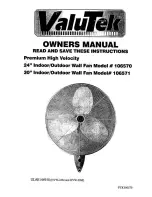
3
Upblast Centrifugal Roof Exhaust Fans
and along all walls should be provided to permit air
circulation and space for inspection.
Outdoor
Fans designed for outdoor applications may be stored
outdoors, if absolutely necessary. Roads or aisles for
portable cranes and hauling equipment are needed.
The fan should be placed on a level surface to prevent
water from leaking into the fan. The fan should be
elevated on an adequate number of wooden blocks so
that it is above water and snow levels and has enough
blocking to prevent it from settling into soft ground.
Locate parts far enough apart to permit air circulation,
sunlight and space for periodic inspection. To minimize
water accumulation, place all fan parts on blocking
supports so that rain water will run off.
Do not cover parts with plastic film or tarps as these
cause condensation of moisture from the air passing
through heating and cooling cycles.
Fan wheels should be blocked to prevent spinning
caused by strong winds.
Inspection and Maintenance During
Storage
While in storage, inspect fans once per month. Keep a
record of inspection and maintenance performed.
If moisture or dirt accumulations are found on parts,
the source should be located and eliminated. At each
inspection, rotate the wheel by hand ten to fifteen
revolutions to distribute lubricant on motor. If paint
deterioration begins, consideration should be given to
touch-up or repainting. Fans with special coatings may
require special techniques for touch-up or repair.
Machined parts coated with rust preventive should be
restored to good condition promptly if signs of rust
occur. Immediately remove the original rust preventive
coating with petroleum solvent and clean with lint-free
cloths. Polish any remaining rust from surface with
crocus cloth or fine emery paper and oil. Do not destroy
the continuity of the surfaces. Thoroughly wipe clean
with Tectyl
®
506 (Ashland Inc.) or the equivalent. For
hard to reach internal surfaces or for occasional use,
consider using Tectyl
®
511M Rust Preventive, WD-40
®
or the equivalent.
Removing From Storage
As fans are removed from storage to be installed in their
final location, they should be protected and maintained
in a similar fashion until the fan equipment goes into
operation.
Installation
Typical Roof Mounting Installation
1. On the roof surface, cut an appropriate sized hole
and follow manufacturer’s instructions on curb
installation. Caulk and flash the curb to ensure a
water tight seal.
2. If unit is equipped with a backdraft damper, it
should be installed now.
3. Remove motor cover. Access to the motor
compartment is accomplished by removing the
screws as shown in figure 3.
4. For CUBE Belt Drive fans only. On the drive frame
use the lifting lugs to lift and place the unit on top of
roof curb. (Refer to figure 2 on page 2).
5. Secure fan to curb using a minimum of eight lag
screws, metal screws or the suitable fasteners.
Shims may be required depending upon curb
installation and roofing material.
6. Verify power line wiring is de-energized before
connecting fan motor to power source.
7. Connect power supply wiring to the motor as
indicated on the motor nameplate or terminal box
cover. Check the power source for compatiblity
with the requirements of your equipment.
8. Check fan wheel for free rotation, re-center if
necessary.
9. Check all fasteners for tightness.
10. Mount and wire safety disconnect switch under
motor cover. Wire control switches at ground level,
refer to figure 4.
11. Replace motor cover.
12. For restaurant and UL Listed for smoke evacuation
applications, the electrical supply must enter the
motor compartment through the breather tube. For
other non-flammable applications the electrical
supply can be routed through the conduit chase
between the curb cap and the bottom of the motor
compartment.
MOTOR
L1
115/208-230/60/1
208-230/460/60/3
MOTOR
J-BOX
J-BOX
SUPPLY VOLTAGE
SUPPLY VOLTAGE
L2
L1
L2
L3
Typical Wiring Diagram
Fig. 4
WARNING
Installation, troubleshooting and parts replacement is
to be performed only by qualified personnel. Consult
and follow all applicable national, state and local
codes. They will supercede this document.
WARNING
Disconnect power before installing or servicing.
®






























